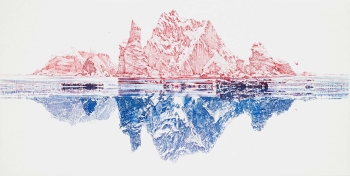Last fall, “The Portrait of Edmond Belamy,” an artwork made by an artificial intelligence (AI) algorithm, was sold for $432,500 at a Christie’s auction in New York. The advent of AI that can generate new images has caused the art world to question the definition of an artist.
In 2019, a Korean art startup Pulse 9 undertook a crowd-funding project of a collaborative artwork “Commune with…” The artwork is by illustrator Doomin and Imagine AI, which is an AI algorithm by Pulse 9. Art crowdfunding platform Art Together participated in the project, for which Joo Mary worked as the art director. She is currently the art director of the AIA art gallery where “Commune with…” is being exhibited as part of “Engineer Exhibition- Preview Extension.”

“Part of our crowd funding project’s intent was to observe whether the general public would accept AI-generated images as art. That it succeeded in collecting over 25 million won is notable,” Joo said.
Although she was initially doubtful of AI painters, her thoughts changed while participating in the project, leading her to join AIA art gallery, which sells AI-made artworks.
Joo focuses on the aspect that AI can learn using data. She explained how AI can stimulate creativity.
“AI learns an extremely large amount of data and generates something that surpasses what it has learned in a unique way,” Joo said.
Joo emphasized that AI art algorithms figure relationships of ideas that lead to artistic images in a novel method. For example, Joo explained that there are aesthetic images used very often in expressing an intent, such as the image of a horizon when attempting to express boundaries. She added that AI can help artists find new relationships for their intent and expand creativity in art.
Furthermore, AI painters can redeem the technical aspect of creating artwork, which leads to the inclusion of engineers as artists. Joo points out that this will push artists forward to make art more interesting, just as when cameras motivated them to experiment with abstractions.
She added that engineers tend to approach art with a novel clarity. Joo expects this clarity to be attractive to the audience. Studying aesthetics in graduate school, Joo found contemporary artists utilizing complexity and ambiguity to allow open analysis, which at times seemed to backfire and tired the audience. Joo said the clarity is best shown in how engineers named their works for the exhibition.

An example is “Yun Dong-ju’ Star Swap.” Star Swap is the name of the algorithm used to create the piece. The artwork is in two canvases, where one is a portrait of Yun Dong-ju the poet composed of AI-generated star images. The other canvas reuses the same stars but aligns them to form a gradation of white to black.
“The name of the work encompasses its meaning, the purpose of the artist and the process of its making,” Joo said.
Many people are visiting the AIA art gallery. In three weeks since its opening, the number of visitors surpassed 300 people. She also commented that the visitors were mostly those in their 20s or 30s.
AIA art gallery also opens auctions for engineers and artists to show and sell their works made with AI technology. The last auction on Feb. 28, which was initially planned as an offline event, was held online via live stream on YouTube due to the COVID-19 outbreak. Despite the abrupt change, the auction sold all six of their exhibited artworks.
“AI technology blending into art is inevitable,” Joo concluded. “Our trials with AI technology can be an example that it is a fascinating tool we can use.”

